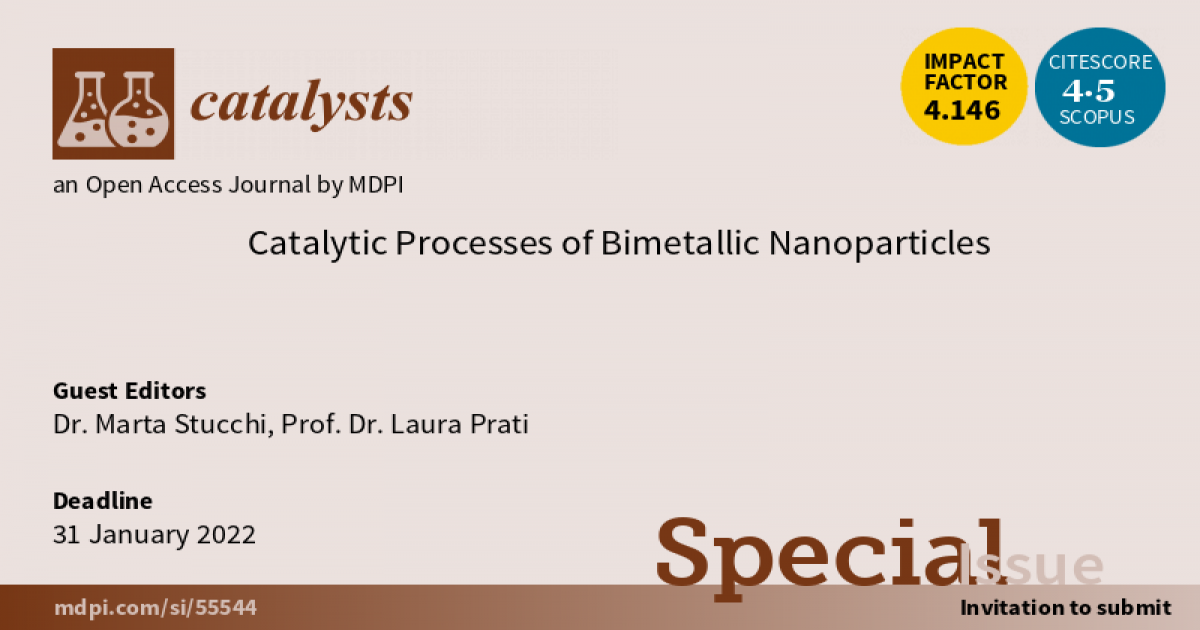Catalytic Processes of Bimetallic Nanoparticles
A special issue of Catalysts (ISSN 2073-4344). This special issue belongs to the section "Nanostructured Catalysts".
Deadline for manuscript submissions: closed (31 January 2022) | Viewed by 6862

Special Issue Editors
Interests: heterogeneous catalysis in liquid-phase; metal nanoparticles for catalysis; explore the properties of non-noble metals for catalysis; NMR relaxometry to study the interaction between substrate and catalyst surfaces; hydrogenation/hydrogenolysis for biomass valorization; oxidation process of biomass derived molecules for biochemical production
Special Issues, Collections and Topics in MDPI journals
Interests: environmental catalytic processes; selective oxidation of organic compounds; gold-based catalysts; metal nanoparticles synthesis; nano-materials synthesis and characterization; carbon-based catalysts; biomass valorization; catalytic sustainable processes
Special Issue Information
Dear Colleagues,
Gold-based catalysts have been the subject of intensive research interest since the inspiring discovery of the high activity of gold nanoparticles (NPs) for CO oxidation. Supported gold NPs have shown promising catalytic performance for a variety of reactions, including propene oxidation, water–gas shift reaction, selective oxidation of alcohols, selective hydrogenation of unsaturated aldehydes, and elimination of volatile organic compounds. Moreover, due to their surface plasmon resonance, supported gold nanoparticles exhibit photocatalytic activity for hydrogen production, environmental pollution control, low-temperature catalytic combustion, and reduction of nitrogen oxides, with the advantage of being active in visible light. Most recently, gold bimetallic nanocatalysts have attracted much interest, with the aim of improving activity, selectivity, and durability. In fact, nanoparticles composed of two different metal elements show novel electronic, optical, catalytic, or photocatalytic properties compared to monometallic ones, showing not only the combination of the properties in relation to the presence of two individual metals but also new properties due to a synergy between two metals.
The structure of bimetallic nanoparticles can be oriented in random alloy, alloy with an intermetallic compound, cluster-in-cluster, or core–shell, and it is strictly dependent on the preparation methods and conditions. The structure affects the physicochemical properties of the resulting nanomaterial, hence a thorough characterization is crucial.
This Special Issue is dedicated to the synergistic effect in gold bimetallic NPs, for both catalytic and photocatalytic processes. It focuses on the potential of Au bimetallic systems and their applications for different aims, with particular attention to green and sustainable processes, environmental chemistry, and energy production. Reviews and original research papers are invited from fundamental to industrial applications on Au bimetallic structures where the synergistic effect plays a crucial role in enhancing the overall process.
Dr. Marta Stucchi
Prof. Dr. Laura Prati
Guest Editors
Manuscript Submission Information
Manuscripts should be submitted online at www.mdpi.com by registering and logging in to this website. Once you are registered, click here to go to the submission form. Manuscripts can be submitted until the deadline. All submissions that pass pre-check are peer-reviewed. Accepted papers will be published continuously in the journal (as soon as accepted) and will be listed together on the special issue website. Research articles, review articles as well as short communications are invited. For planned papers, a title and short abstract (about 250 words) can be sent to the Editorial Office for assessment.
Submitted manuscripts should not have been published previously, nor be under consideration for publication elsewhere (except conference proceedings papers). All manuscripts are thoroughly refereed through a single-blind peer-review process. A guide for authors and other relevant information for submission of manuscripts is available on the Instructions for Authors page. Catalysts is an international peer-reviewed open access monthly journal published by MDPI.
Please visit the Instructions for Authors page before submitting a manuscript. The Article Processing Charge (APC) for publication in this open access journal is 2200 CHF (Swiss Francs). Submitted papers should be well formatted and use good English. Authors may use MDPI's English editing service prior to publication or during author revisions.
Keywords
- synergistic effect—theoretical aspects
- synergistic effect—practical aspects
- gold-based bimetallic catalysts
- gold-based bimetallic photocatalysts
- sustainable processes
- biomass valorization
- hydrogen production
- sustainable energy
- water treatment
- pollution abatement
- solar-driven processes
- bimetallic nanoparticles synthesis
- bimetallic nanoparticles characterization
- structure–activity relationship
Benefits of Publishing in a Special Issue
- Ease of navigation: Grouping papers by topic helps scholars navigate broad scope journals more efficiently.
- Greater discoverability: Special Issues support the reach and impact of scientific research. Articles in Special Issues are more discoverable and cited more frequently.
- Expansion of research network: Special Issues facilitate connections among authors, fostering scientific collaborations.
- External promotion: Articles in Special Issues are often promoted through the journal's social media, increasing their visibility.
- Reprint: MDPI Books provides the opportunity to republish successful Special Issues in book format, both online and in print.
Further information on MDPI's Special Issue policies can be found here.






